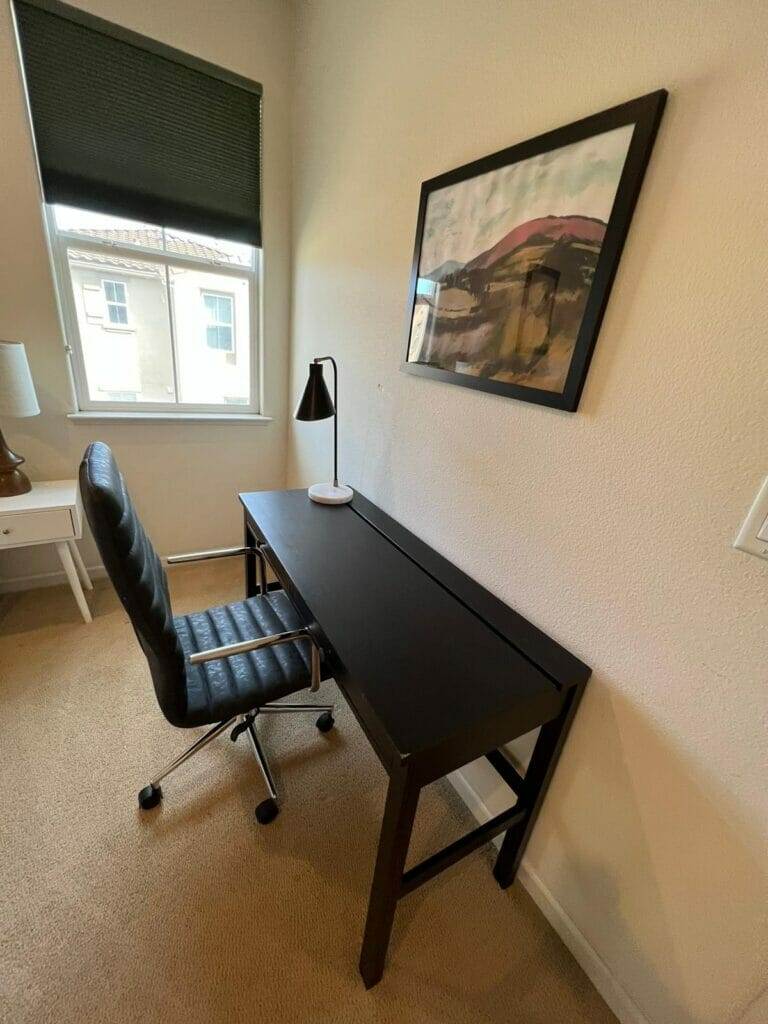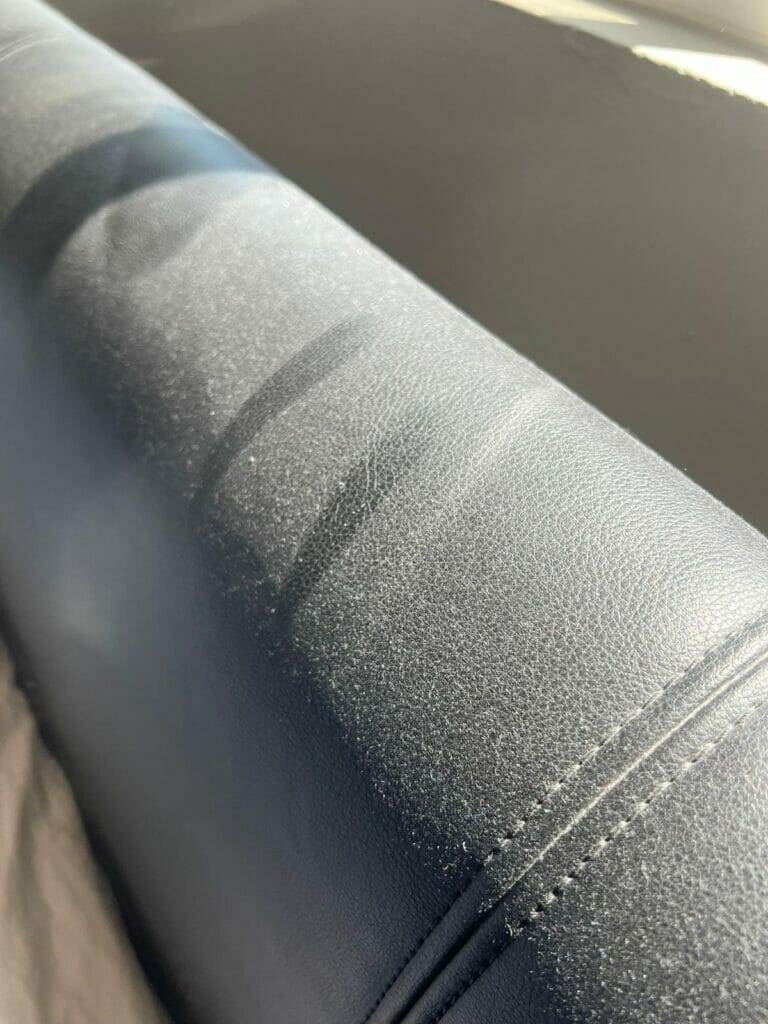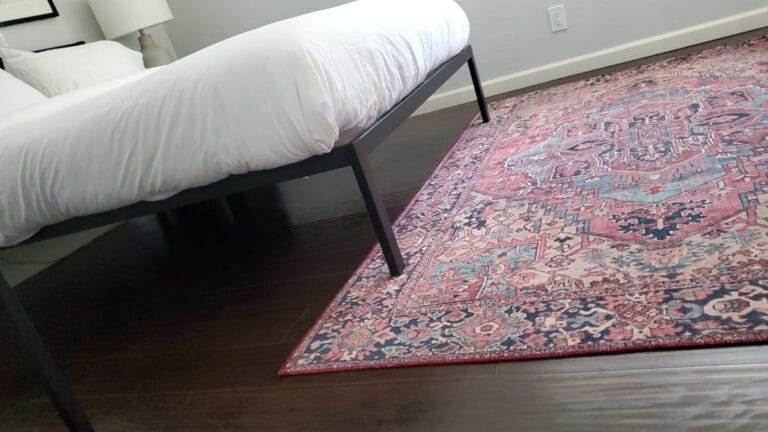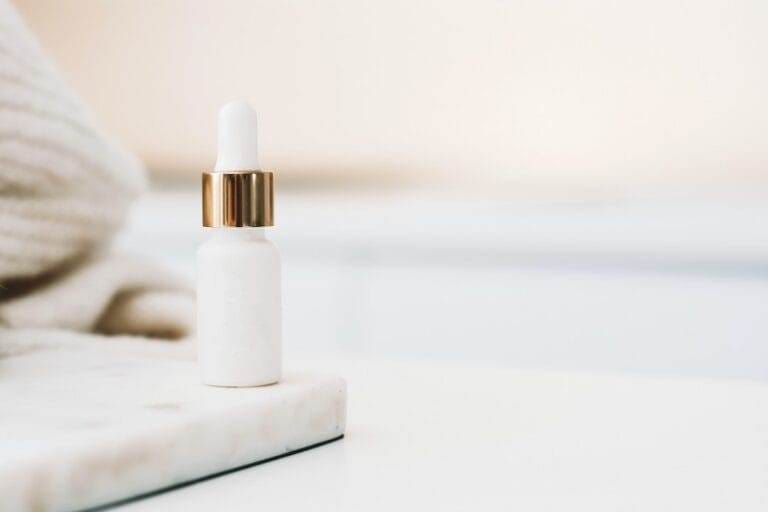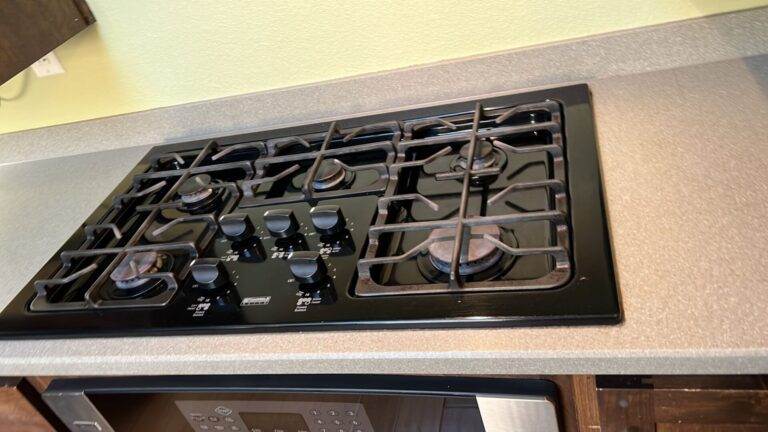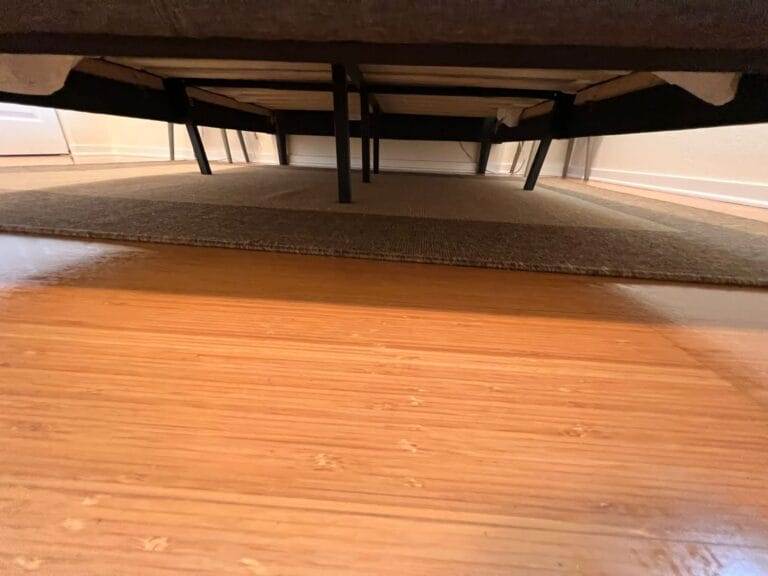How to clean a leather couch?
Cleaning a leather couch requires some simple but necessary steps. Start by wiping the surface of the leather with a soft cloth that has been dampened with warm water. Make sure to wring out any excess water from the cloth to ensure it is just damp, not soaked.
After wiping, immediately dry the couch using a different dry cloth. This step is crucial as leaving moisture on the leather could cause damage over time. Always perform these steps on an inconspicuous part of your couch first to ensure they won’t affect its appearance.
Once you have cleaned and dried your couch, apply a small amount of leather cream to a clean cloth and gently work it into the surface of the sofa. The cream will help keep the leather supple and shiny. After applying the cream, take a clean towel and carefully remove any surplus product from the couch.
Remember that frequent cleanings can help extend the life and improve the look of your beloved leather couch!
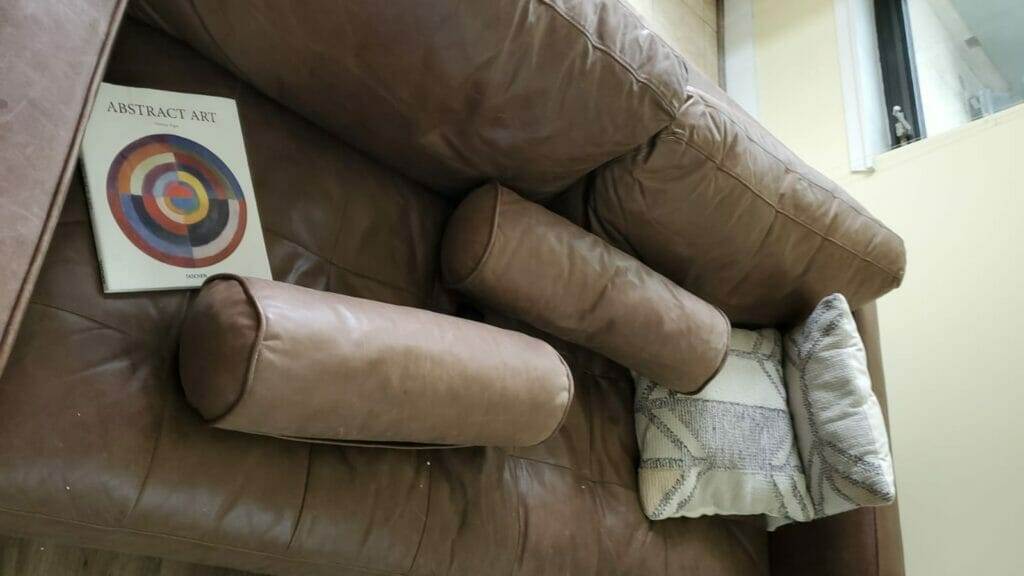
Tips to keep your leather couch clean
Maintaining the appeal of your leather furniture, especially your sofa, involves regular cleaning and maintenance. Cleaning a leather couch doesn’t have to be daunting or time-consuming if you follow a simple routine. Start by dusting off any debris using a dry cloth or vacuum. Next, wipe down the surface with a damp cloth. Avoid soaking the leather as it can cause damage over time. For deeper cleaning, consider using a mild soap solution or specialized leather cleaner and condition with a good quality leather conditioner afterward to keep the leather supple and prevent cracking. Remember to always do a patch test before applying any product to the entire couch and never use harsh chemicals or abrasive cleaners which can compromise the integrity of the leather.
Best ways to remove stains from a leather couch
Removing stains from a leather sofa or couch requires a careful approach to avoid additional damage. Here’s a simple method and best thing to clean leather:
- First, dust off any loose dirt using a dry cloth.
- Make a solution of equal parts warm water and mild dish soap. For every quart of water, add one tablespoon of soap.
- Dip a soft cloth into the solution, wring out excess moisture until it’s just damp, not soaking wet.
- Gently clean the stained area with the damp microfiber cloth.
- Rinse out the cloth with fresh water and wipe away any leftover soap on the couch.
- Immediately dry the area with a clean towel.
- Finally, consider applying a leather conditioner to help maintain the texture and appearance of your couch.
Always test area of the leather on an inconspicuous spot before applying any cleaning solutions on visible areas.
How often should you clean a leather couch?
A leather couch should be dusted weekly with a soft cloth. However, a deep cleaning with a suitable leather cleaner is recommended every six months to keep it in the best condition.
The importance of using leather conditioner
Leather conditioner is crucial for maintaining the longevity and preserving the natural beauty of leather goods. Over time, leather can dry out and become brittle, especially if it’s exposed to harsh conditions or not properly cared for. A good leather conditioner penetrates the material, providing essential oils and lubrication to keep the fibers strong and supple. This prevents cracking, fading, and peeling, thus extending the life of your leather items. It also enhances the color and luster of leather, giving it a fresh and revitalized appearance.

Types of leather and how to clean them
There are several types of leather, each with its own unique characteristics and cleaning methods.
Full-Grain Leather: This is the highest quality of leather, known for its durability and breathability. It’s made from the outermost layer of animal skin and has all natural imperfections. To clean full-grain leather, simply wipe it down with a damp cloth. For tougher stains, use a specially formulated leather cleaner.
Top-Grain Leather: One step below full-grain, top-grain leather has been lightly sanded to remove imperfections but still maintains high durability. Cleaning is similar to full-grain — Use a damp cloth or specific leather cleaner.
Genuine Leather: Considered the third best type of leather, genuine leather is made from leftover hide once the top layers have been removed. It’s less durable but more affordable than other types. To clean, gently rub with a damp cloth and mild soap if necessary.
Bonded Leather: The lowest quality of real leathers, bonded leather is made by bonding together leftover scraps of hide with glue and then painted to look like real leather. Cleaning can be done using a damp cloth or mild soap.
Suede and Nubuck: These leathers are both created by raising fibers on the grain side (nubuck) or underside (suede) of the hide to create a velvety appearance and touch. They need special care due to their sensitive nature — it’s better to use cleaning products specifically designed for suede or nubuck.
Patent Leather: This type has an extremely glossy finish achieved via coating in plastic or resin. Cleaning patent leather involves wiping with a damp cloth then buffing dry immediately after to maintain shine.
Remember that before applying any cleaning product on your leather item, always perform a patch test in an inconspicuous area first.
How to clean a leather sofa?
To clean a leather sofa, follow these simple steps:
- Start by vacuuming the sofa to remove any loose dirt and debris.
- Mix a solution of mild soap and warm water.
- Dampen a soft cloth with the soapy water and gently wipe down the entire surface of the sofa.
- Pay extra attention to any stains or spills, using a gentle circular motion to clean them.
- Rinse the cloth with clean water and wring out any excess moisture.
- Use the damp cloth to wipe away any soap residue from the sofa.
- Finally, buff the leather with a dry, soft cloth to restore its natural shine.
By following these steps, you’ll have your leather sofa looking clean and inviting in no time!
Using the right cleaner for your leather sofa
I recommend using the appropriate cleaner for your leather sofa to keep it looking its best and ensure its longevity. It’s important to use a product specifically designed for leather surfaces, as other cleaners may be too harsh and can damage the material. By using the right cleaner, you can maintain the beauty of your leather sofa for years to come.
Simple steps to wipe down a leather sofa
Start by dusting off your leather sofa with a soft, dry cloth to remove any loose dirt or debris.
Mix a few drops of mild dish soap with warm water, dampen a soft cloth in the solution and gently wipe down the sofa.
Afterward, use another dry cloth to thoroughly dry the surface to prevent moisture damage.
How to clean and condition leather furniture
Cleaning and conditioning leather furniture requires gentle care and specific products. Start by vacuuming the surface with a soft brush attachment to remove dust and small particles. Then, wipe it using a damp cloth soaked in a mix of warm water and mild dish soap. Do not over-wet the leather as it can damage it. Once cleaned, dry it gently with a towel; avoid using hair dryers because they might dehydrate the leather.
For conditioning, apply a good-quality commercial leather conditioner following its instructions. Usually, you have to distribute it evenly on the leather’s surface, wait for some time (as per product’s guidance), and then buff away any excess product with a clean cloth. Conditioning helps maintain the flexibility of leather and prevents cracks or splits. It’s recommended to do this every six months.
Dealing with grease stains on a leather sofa
Dealing with grease stains on a leather sofa can be tricky but not impossible. Start by dabbing the stain gently with a clean, dry cloth to absorb as much grease as possible. Then, sprinkle baking soda or cornstarch over the stain and let it sit overnight. These substances work wonders at absorbing grease. The next day, use a soft brush to gently remove the powder. If the stain persists, apply a small amount of mild leather cleaner using circular motions, then wipe away with a damp cloth and let it dry naturally. Always remember to do a patch test before applying any solution directly on the stain.
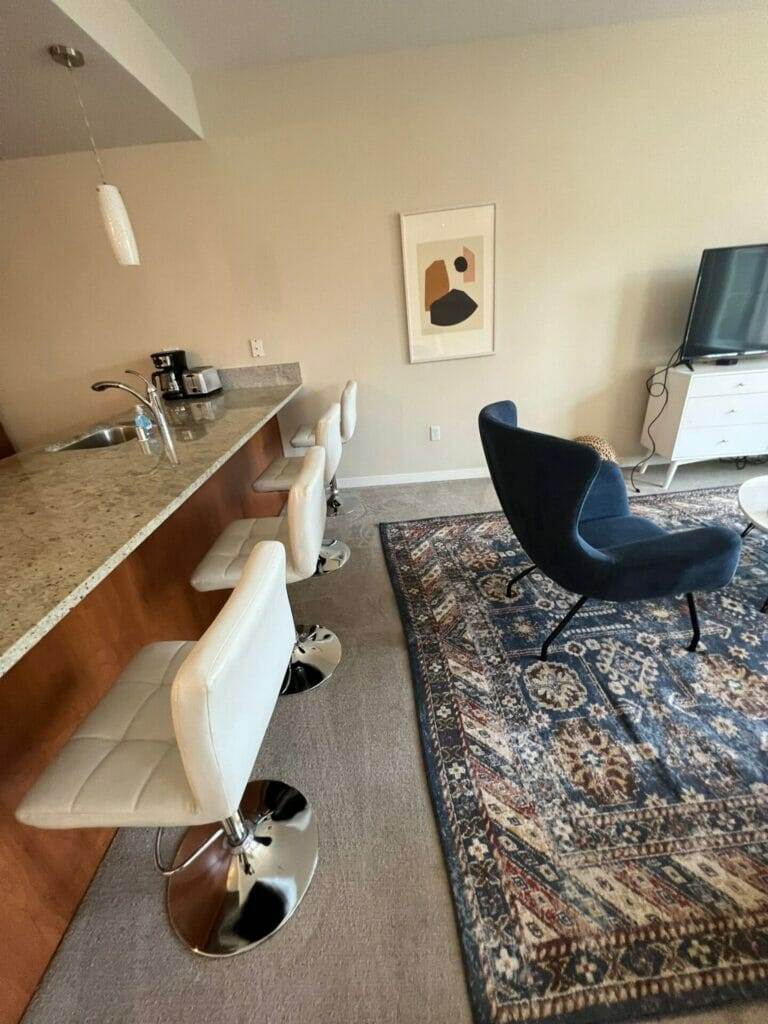
Removing ink stains from a leather sofa
Materials Needed:
Mild Soap or Leather Cleaner
Soft Cloth
Rubbing Alcohol
Cotton Swabs
Leather Conditioner
Procedure:
Begin by testing your leather cleaner or mild soap on an inconspicuous part of your sofa to ensure it doesn’t discolor or damage the leather.
Using a soft cloth and warm water with a small amount of mild soap or leather cleaner, gently clean off any dirt or residue from around the stain. This will prevent additional dirt from being worked into the leather during the stain removal process.
Dip a cotton swab into rubbing alcohol and delicately dab at the ink stain – avoid rubbing as this could cause the ink to spread more.
Once you’ve applied the rubbing alcohol, let it sit for about 30 minutes so it can penetrate and break up the ink.
After 30 minutes, if there is still visible ink, you might need to repeat step 3 again until no more ink lifts onto your cotton swab.
After removing as much of the stain as possible, make sure you condition your leather sofa – using a good-quality leather conditioner will help maintain its natural oils and keep it supple.
Remember not to soak your leather furniture in water or try to scrub out an ink stain as these methods can cause further damage.
Disclaimer: Despite our best efforts and use of professional techniques, please note that Master Clean is not liable if the ink stain spreads during our cleaning process. Ink stains can be particularly challenging to remove completely without any spread or residue, especially on porous surfaces like leather. Please understand these risks before proceeding with any cleaning or stain removal process.
What is the best way to clean leather furniture?
Often to clean a leather furniture properly can maintain its quality and longevity. Here’s a simple guide to follow:
Dust Regularly: Just like any other piece of furniture, dusting your leather upholstery should be part of your routine cleaning. Use a soft, dry cloth or feather duster to clean the surface every few days.
Vacuum: Vacuum the crevices and corners where dust can accumulate with a brush attachment once a week.
Wipe Down: Every two weeks, wipe down your leather furniture with a damp cloth. It’s essential not to soak the material – just lightly dampen it. Make sure you’re using distilled water because tap water often contains chlorine which can damage the leather.
Condition: Leather tends to dry out over time, so conditioning is crucial. Apply a leather conditioner every 6-12 months to keep the material supple and prevent cracking.
Spot Cleaning: If there are spills or stains on the furniture, immediately blot them with a clean dry cloth – don’t rub as this may cause the stain to spread or go deeper into the leather.
For stubborn stains, use a mild soap solution (a few drops in distilled water). Test this on an inconspicuous area first before applying it on visible surfaces; some leathers may react adversely to soap.
Professional Cleaning: Depending on how dirty your furniture gets, you might consider getting it professionally cleaned every 1-2 years.
Remember: It’s key not to expose your leather pieces directly under sunlight for prolonged periods as this could lead to fading and drying out.
Choosing the right upholstery cleaner for leather furniture
When choosing an upholstery cleaner for leather furniture, consider a product specifically formulated to keep a leather and maintain its durability and luster. It should condition as well as clean to prevent the leather from drying or cracking. Check for non-toxic and pH balanced cleaners that won’t cause any discoloration or damage. Avoid cleaners with harsh chemicals like ammonia or bleach. Always remember to do a patch test in an inconspicuous area before using any new product on your furniture.
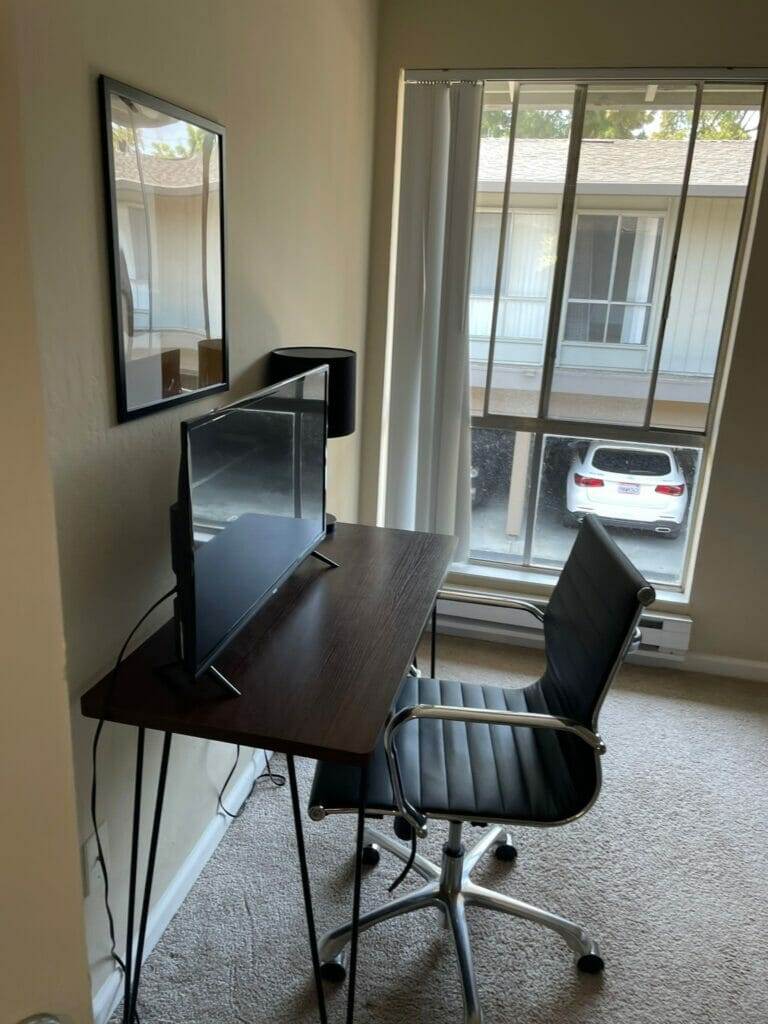
Homemade leather cleaning solutions that work
White Vinegar and Water Solution: Mix equal parts vinegar and water in a bowl. Dip a soft cloth into the solution and wring it out so it’s damp, but not wet. Wipe down the leather with the cloth.
Soap and Water Solution: Mix a solution of warm water and dish soap, dip a soft cloth into it, wring it out and wipe the exterior surfaces of the purse.
Lemon Juice and Cream of Tartar Paste: Mix equal parts lemon juice and cream of tartar to make a paste, apply to stained area on your leather item then let sit for 30 minutes before wiping off.
Always remember to do a patch test in an inconspicuous area first to make sure that these homemade solutions will not discolor or damage your leather items!
How to clean leather upholstery with vinegar and water
To clean leather upholstery, mix equal parts vinegar and water in a spray bottle. Test the solution on a small area first. Then, gently wipe the entire surface with the damp cloth using circular motions. Allow it to air dry completely.
Steps to clean your leather furniture properly
Gather Your Cleaning Materials: You’ll need a vacuum cleaner with a brush attachment, mild cleaning with soap (like dish soap), several soft cloths, water, and a bucket.
Remove Surface Dust and Dirt: Use the vacuum cleaner with the brush attachment to remove any dust or loose dirt from the surface of your furniture. Make sure to get into all the crevices and corners.
Prepare Your Soap Solution: Mix a few drops of mild soap in the bucket of lukewarm water until it’s slightly sudsy.
Test the Soap Solution: Dip a cloth into your soap solution, wring it out so it’s damp but not dripping wet, and test it on an inconspicuous part of the leather furniture first to make sure it doesn’t discolor or damage the leather.
Clean the Leather Furniture: If the test spot is unharmed, go ahead and clean your leather furniture by gently wiping down its surface with your damp cloth. Be careful not to soak the leather since this could damage it further.
Dry Your Leather Furniture: After cleaning, use another dry soft cloth to wipe off any remaining soap solution from your furniture then let it air dry completely before using again.
Condition The Leather: After drying, apply a high-quality leather conditioner following manufacturer’s instructions to maintain its suppleness and prevent cracking or drying out and clean longer.
Remember that less is more when cleaning leather; too much water or soap can cause damage. If you’re dealing with tough stains or discoloration, you may want to consider hiring a professional cleaner that specializes in leather care. Always follow the manufacturer’s guide for cleaning tips.

Using a leather care kit for regular cleaning
Dust off the Leather: Wipe down the leather furniture with a dry, clean cloth to remove any surface dirt or dust.
Prepare the Water-Based Cleaner: Mix your water-based cleaner according to the instructions on the kit. Generally, you’ll mix it with some warm water in a bowl.
Apply the Cleaner: Dip a clean soft cloth into the solution and wring it out so that it’s damp but not soaking wet. Begin wiping down your furniture with this damp cloth in a circular motion starting from top to bottom.
Dry Your Furniture: Once all sections have been cleaned, use a dry towel to gently blot any excess water or cleaner off of your leather furniture. Do not rub as it can damage the leather’s finish.
Apply Conditioner/Protector: If your kit includes conditioner or protector, apply it after your furniture has fully dried using another clean cloth and again following package directions specifically for conditioner application.
Buff and Polish (Optional): For an extra shine, you can buff out your furniture with another dry, clean cloth once everything is dry.
Remember that less is more when it comes to cleaning products even if they’re designed for leather – too much can lead to discoloration or other damage over time.
Always try testing any new cleaner or conditioner on an inconspicuous area first before applying it all over.
How to keep your leather couch and furniture clean?
Keeping your leather couch and furniture clean and in pristine condition requires regular care and proper handling. Here are some steps to properly clean and maintain them:
Regular Dusting: Make sure to dust off your leather furniture weekly using a soft cloth.
Vacuum Cleaning: Vacuum all the crevices and corners of your leather furniture, preferably once a week, to remove any debris or loose dirt.
Spot Cleaning: If there are any stains, immediately dab with a dry cloth—don’t rub, as this can spread the stain. For stubborn spots, you can use a damp cloth with warm water and mild soap.
Use Leather Cleaners: For deep cleaning, use a good quality commercial leather cleaner according to the manufacturer’s instructions.
Conditioning: Leather tends to dry out over time, so it’s essential to apply a good quality leather conditioner once every 6-12 months.
Avoid Direct Sunlight & Heat Sources: To prevent fading and cracking, avoid placing your leather furniture near windows or heat sources like fireplaces or radiators.
Professional Cleaning: In case of serious damage or if the item has not been cleaned for an extended period of time, consider hiring professional help for thorough cleaning and restoration.
Remember not to use harsh chemicals or abrasive cleaners on leather as they can damage its surface and cause discoloration.
Preventing stains and damage to your leather furniture
Maintaining the elegance of your leather furniture requires regular care and attention. Preventing stains on your leather and damage starts with a consistent cleaning routine, using specially designed products that can gently remove dirt without damaging the leather. Avoiding direct sunlight is also crucial because it may cause the color to fade or even crack over time. Similarly, sharp objects should be kept away from your furniture to prevent scratches. Lastly, treating spills immediately by blotting (not rubbing) them up can help prevent stain formation. By following these tips, you can ensure that your leather furniture retains its appeal for years to come.
Regular maintenance tips for leather couch and furniture
Regular maintenance of leather furniture is essential to prolong its lifespan and maintain its aesthetics. Here are some tips:
Regular Dusting & Vacuuming: Use a soft cloth or microfiber to dust off the surface weekly. For hidden areas, use a vacuum cleaner.
Avoid Direct Sunlight: Leather can fade or dry out when exposed to direct sunlight for prolonged periods.
Wipe Spills Immediately: Any liquid spills should be wiped immediately with a clean cloth to prevent staining.
Condition Regularly: Conditioning your leather furniture every 6-12 months helps maintain its suppleness and prevent cracks.
Avoid Sharp Objects: Keep sharp objects away from your leather furniture to avoid scratches and tears.
In essence, regular cleaning coupled with suitable protection methods can significantly extend the life and appearance of your leather furniture.
What is the best way to deal with specific stains on leather?
Here are some steps to deal with specific stains on various types of leather:
Finished Leather
Ink Stains: Use rubbing alcohol. Dab a cotton swab in it and gently rub over the stain until it’s gone. Do not rub vigorously as it could remove the color.
Grease Stains: Sprinkle baking soda or cornstarch on the stain. Let sit for a few hours, then wipe away with a clean cloth.
Dark Stains (like red wine, blood): Mix a paste of one part lemon juice and one part cream of tartar. Apply to the stain and leave on for 10 minutes, then wipe off with a damp cloth.
Water Spots: Moisten entire cushion or area where water spot occurred with a sponge (not just the spot itself) until evenly wet, then let air dry.
Rejuvenating Leather
Clean your leather item first by lightly dampening it and applying a mild soap solution before wiping away any excess moisture.
Apply a good quality leather conditioner to keep it from drying out and cracking – this helps to restore its natural oils.
Regularly buffing your leather item can help keep its shine intact.
Leather Material
Always remember that different types of leather require different care procedures and products, so always ensure you’re using the appropriate method for your specific type of leather material.
Finally, for all types of leathers if stains persist after trying these methods at home, you may want to consider hiring professional services to avoid damaging your item further.
Removing grease stains from leather
Removing grease stains from leather can be a bit tricky, especially when it comes to furniture such as couches or chairs. Here’s a step-by-step guide on how you can accomplish this with ease:
Step 1: Begin by blotting the grease stain with a clean, dry cloth. Make sure not to rub it in further.
Step 2: Sprinkle a layer of baking soda or cornstarch directly onto the stain. These substances are excellent at absorbing oils and can easily draw out the grease.
Step 3: Let the baking soda or cornstarch sit on the stain for about 15 minutes. This allows sufficient time for absorption.
Step 4: Then, gently brush away the powder using a soft-bristled brush.
Step 5: If any stain remains, apply a leather cleaner specifically designed to treat and clean your type of leather furniture. Always follow the instructions provided by the manufacturer when using these products.
Step 6: After cleaning, condition your leather couch or chair to restore its luster. Use a conditioner that’s suitable for your specific type of leather.
Remember, always test any products or methods on an inconspicuous area first to ensure they won’t cause discoloration or damage.
How to clean leather cushions without damaging them
Sure, let’s dive into the process of cleaning leather cushions without causing any damage.
You might be wondering how to clean leather. Leather is a material that can last for decades if treated properly, and its maintenance is not as hard as you may think. Here are some steps on how to clean leather cushions effectively:
Remove Dust and Loose Debris: Use a vacuum cleaner with a brush attachment to gently remove dust and loose debris from the leather surface.
Make Your Cleaning Solution: Mix equal parts of vinegar and water in a bowl to create your own natural leather cleaner.
Test the Cleaner: Before applying your homemade cleaner, do a spot test on an inconspicuous area of your leather cushion. Apply a small amount of the solution with a soft cloth and let it dry completely to ensure it won’t discolor or damage the material.
Clean the Cushions: If there’s no adverse reaction during the spot test, dampen another soft cloth with your cleaning solution and gently wipe your cushions down.
Dry Your Cushions: After cleaning, use another clean cloth to dry off the excess moisture from your cushion instead of letting it air dry.
Condition Your Cushions: As leather can dry out over time, you should condition it regularly to keep it supple and prevent cracks. There are plenty of commercial conditioners available but you can also make one at home by mixing one part vinegar with two parts linseed oil.
Remember to always keep your leather furniture away from direct sunlight and heat sources as they tend to dry out the material leading to premature aging and cracking.
Using rubbing alcohol to remove stubborn stains from leather
Rubbing alcohol can be an effective solution for removing stubborn stains from your leather items. First, you will need to dilute the rubbing alcohol with water, using a ratio of one part alcohol to one part water. Apply this solution using a soft cloth, gently rubbing it into the stain. It’s important not to soak the leather, as too much moisture can cause damage.
The diluted rubbing alcohol is designed to clean and lift away the stain without damaging the leather surface. Always remember to test any cleaning solution on an inconspicuous area first, as different types of leather might react differently to various cleaning agents. Once the stain has been lifted, allow the leather to dry naturally.
To restore its shine and suppleness after cleaning, consider applying a leather conditioner. With proper care and maintenance, your leather goods can retain their beauty and durability for many years.

